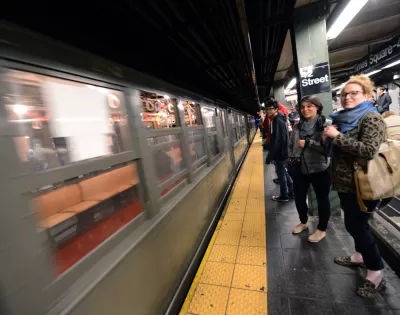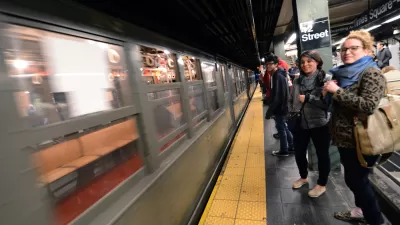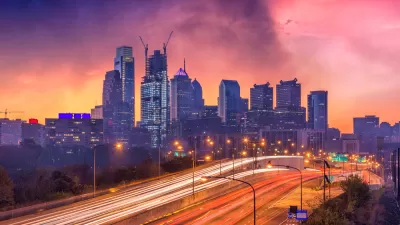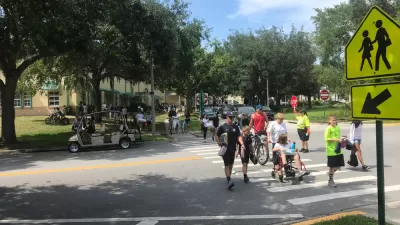When it comes to the Census, the term "alternative transportation" makes perfect sense. Eric Jaffe looks at the 15 metropolitan areas with the lowest auto commuting and describes the most popular alternatives.

While carpooling has been in decline since 1980 in the United States, it is still the second-most popular form of commuting, with 9.4 percent mode share after "drive-alone" at 76.4 percent. However, the Census lumps it with solo commuting, calling it "commute by auto" in the August survey (PDF) entitled, "Commuting by Automobile in the United States: 2013 [Figure 1, page 1 or click here for CityLab reproduction]." So if you are a carpooler, please understand the absence of that popular but declining mode in the foregoing accounting of the most popular alternatives.
Table 2 on Page 6 of the American Commuter Survey is entitled, "Metro Areas Among Those With the Lowest Rates of Automobile Commuting and Their Second Most Common Commute Mode: 2013." [Click here for the CityLab table.] It shows the 15 metros with the lowest rates for any Metropolitan or Micropolitan Statistical Areas (MSAs), from 57 percent for NY-Newark-Jersey City to 79 percent for State College, Pa. [Note that it differs from table 1 which lists "Metro Areas of Populations 500,000 or Greater Among Those With the Largest Declines."]
"The table lends itself to three broad categories," writes Jaffe, CityLab’s New York bureau chief: "Major metros, college towns, and second-ring cities." The following will discuss the second most popular mode in the 15 MSAs, regardless of category, after "commute by auto."
The most popular alternative, surprise, was walking—for four college towns, with Ithaca scoring an incredible 17.5% and the second highest scoring alternative overall. Biking wasn't popular, applicable only to Corvallis, Ore. with 8.8 percent mode share.
Tied for second was "subway or elevated rail" and "bus or trolley bus"—three areas for each mode, all in major metros. New York-Newark-Jersey City, NY-NJ-PA had the highest for any alternative mode: 18.9 percent for subway-elevated rail. For bus, "urban Honolulu" had the highest: 7.9 percent.
Two "second-ringers" were the only ones where commuter rail and ferries were favored: Bridgeport-Stamford-Norwalk, Conn. and Bremerton-Silverdale, Wash, respectively.
Boulder, Colo., which is both a college town and a second-ringer, was the only region where "work-at-home" was the favored alternative.
"So that’s how people get to work in the U.S. cities with the lowest car commute shares," concludes Jaffe.
There’s obviously loads of room for improvement: even on this list, it’s still the norm for seven or eight in 10 people to drive to work (New York City aside). That’s not likely to change in a big way until U.S. cities raise the cost of driving to work, but in the meantime there are some lessons to learn on the margins.
FULL STORY: How Americans Get to Work in Cities With the Lowest Car Commute Rates

Study: Maui’s Plan to Convert Vacation Rentals to Long-Term Housing Could Cause Nearly $1 Billion Economic Loss
The plan would reduce visitor accommodation by 25,% resulting in 1,900 jobs lost.

North Texas Transit Leaders Tout Benefits of TOD for Growing Region
At a summit focused on transit-oriented development, policymakers discussed how North Texas’ expanded light rail system can serve as a tool for economic growth.

Why Should We Subsidize Public Transportation?
Many public transit agencies face financial stress due to rising costs, declining fare revenue, and declining subsidies. Transit advocates must provide a strong business case for increasing public transit funding.

How Community Science Connects People, Parks, and Biodiversity
Community science engages people of all backgrounds in documenting local biodiversity, strengthening connections to nature, and contributing to global efforts like the City Nature Challenge to build a more inclusive and resilient future.

Alabama: Trump Terminates Settlements for Black Communities Harmed By Raw Sewage
Trump deemed the landmark civil rights agreement “illegal DEI and environmental justice policy.”

Dear Tesla Driver: “It’s not You, It’s Him.”
Amidst a booming bumper sticker industry, one writer offers solace to those asking, “Does this car make me look fascist?”
Urban Design for Planners 1: Software Tools
This six-course series explores essential urban design concepts using open source software and equips planners with the tools they need to participate fully in the urban design process.
Planning for Universal Design
Learn the tools for implementing Universal Design in planning regulations.
City of Santa Clarita
Ascent Environmental
Institute for Housing and Urban Development Studies (IHS)
City of Grandview
Harvard GSD Executive Education
Toledo-Lucas County Plan Commissions
Salt Lake City
NYU Wagner Graduate School of Public Service





























